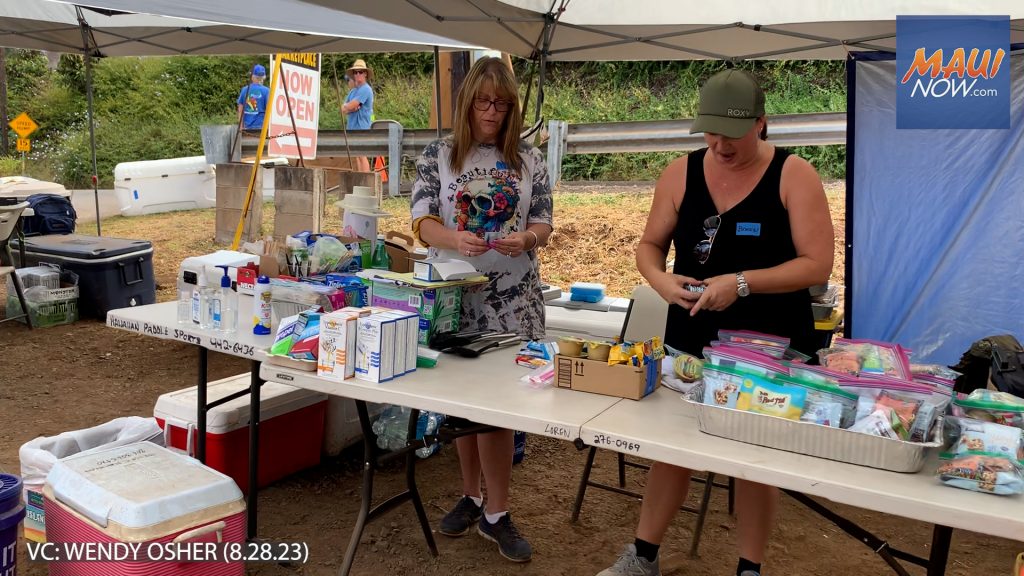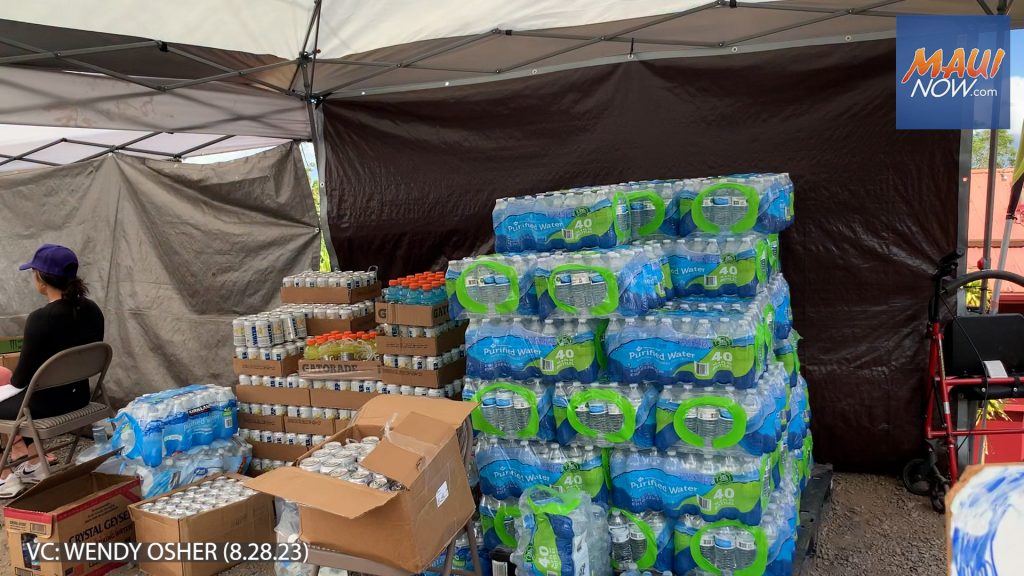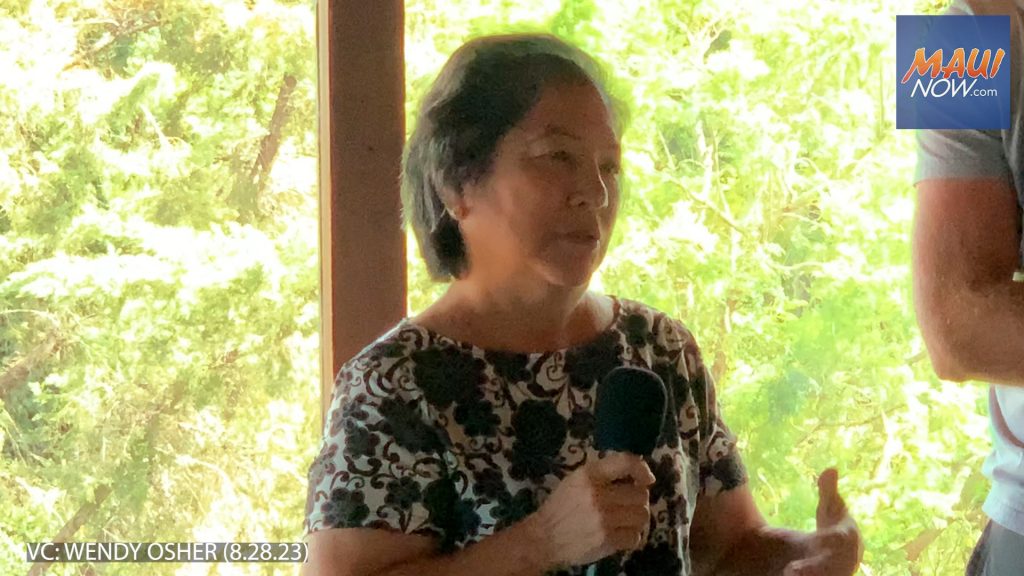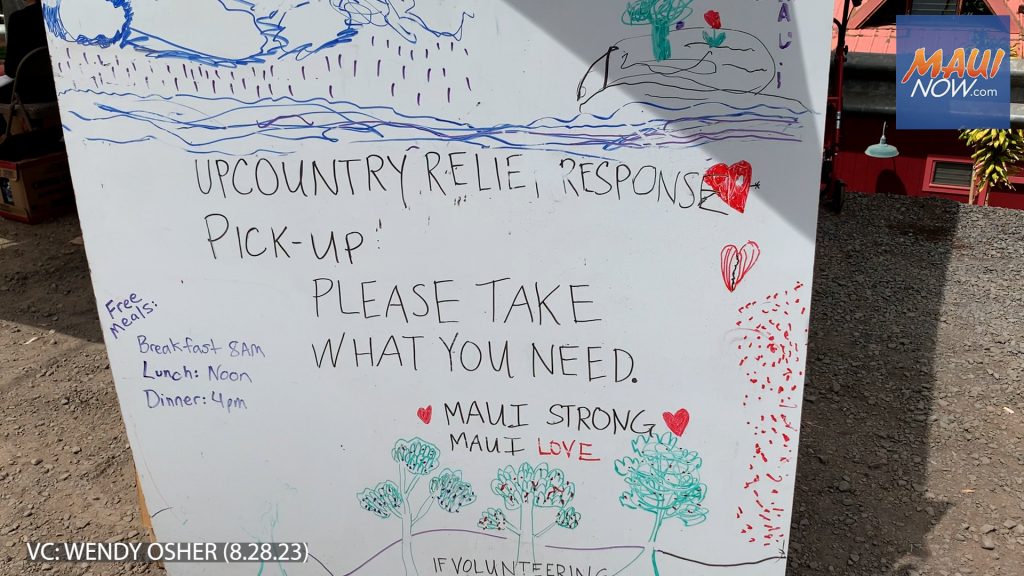Upcountry wildfire survivors grateful to volunteers, discuss recovery with governor
Upcountry wildfire survivors discussed the loss of their homes and the unwavering support of community volunteers who came to their aid in the days following disastrous wildfires on Maui.
Governor Josh Green spent Monday morning listening to their stories, hearing their concerns and collaborating on a path forward during a small gathering at the Kula Lodge.
“I just had time to grab my iPhone, my wallet and everything. I’m 82, and it’s because of the volunteers, because of the friends in the area—the community, strangers—and I’m going to rebuild because I don’t want to leave this,” said Tom Liu, a Kula resident who lost his home in the Aug. 8 wildfires.
Liu, who is originally from North Carolina said, “I hear about your aloha spirit. I’m living in it. This is the first time [that] I’m living in it. I’m the living proof.” He said the volunteers are to be credited for keeping him afloat when he felt there was nothing left.
“I second that,” said a fellow resident who lost her home. “Their efforts are astounding… staggering. It’s unbelievable to see people you don’t know come up to your home and spend 10 hours a day working, and then show up the next day and do it again, and again, and again.”
The sentiment was shared among a group of homeowners who lost everything during the Aug. 8 wildfire in Kula. A total of 19 homes and structures burned in the Kula and Olinda fires in Upcountry Maui; while more than 2,200 structures were damaged or destroyed in Lahaina.
While Lahaina has gotten much of the attention and funding in the initial aftermath because of the sheer devastation that leveled 5.5 square miles and killed at least 115 people, Upcountry residents were glad to be getting the much welcome attention from the governor’s visit on Monday.
“It just alway brings me to tears that people come back and say ‘How can we help,'” said Gayle Hart, who also lost her home on Kulalani Drive. “It’s so good to have you here too because it brings attention to Upcountry, which we haven’t had in many, many days.”
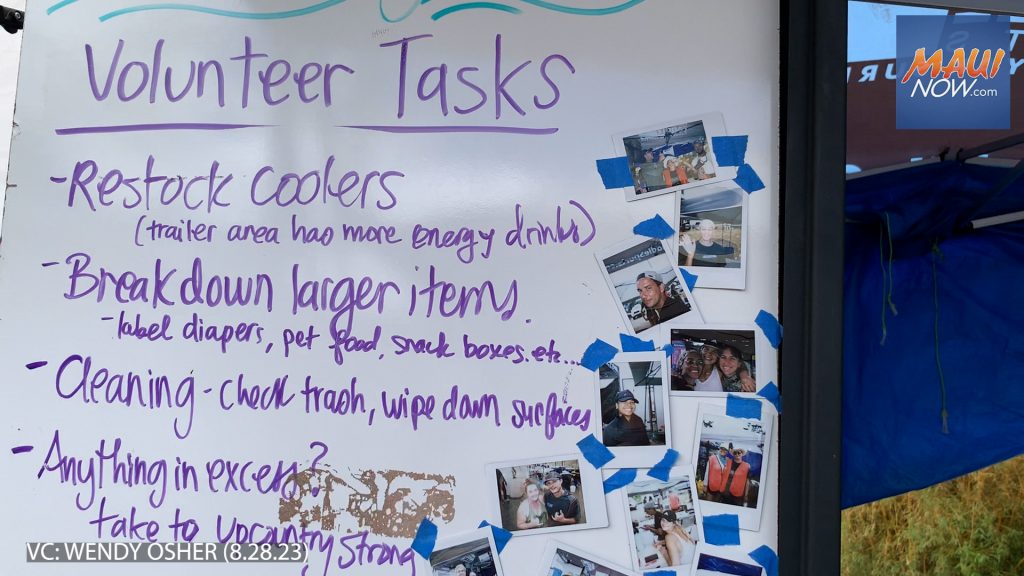
Volunteer, Kyle Ellison said the Kula distribution hub didn’t start until several days after the fire began because for the first four days residents were still involved in actively putting out the fire.
At first, Ellison told people that they could help him by helping Lahaina, “but after about five days, it was like, ‘You know what, we do need help up here.'”
ARTICLE CONTINUES BELOW AD“It only takes a spark to start a fire. Sometimes you just need that one little spark to get a response going, and the community has been the fuel for that,” said Ellison.

“Sometimes when you don’t know where to start, you just start,” said Ellison. “Then other people showed up, helping with supplies and logistics.” Then trucks, trailers, chainsaws, and other resources came. “The next thing you know, we’ve got 200 plus people coming. And Megan [Nakashima] from Pukalani Superette coming up and bringing us food. And then it all just snowballs and happens.”
Nakashima echoed Ellison’s sentiment saying, “We take care of each other up here. It’s because historically, Upcountry has been ignored… We really want to work with government officials, but it’s just been everybody’s been paying attention down there. We get it. There’s a lot of loss, but we need to take care of our community up here. And so Upcountry Strong, we support the community in the ways they need,” she said.
Nakashima also pointed to other groups like Waipuna Chapel, arborists and munchers, and a crew in Olinda putting up firebreaks, but she said, “They need help. They need real help. And we need a lot of water. We’ve been crowdsourcing water. It’s crazy.”
Both Upcountry and Lahaina areas have been under unsafe water advisories for weeks, using only bottled water or potable water provided from tankers for things like drinking, brushing teeth, ice-making and food preparation.
“We recognize that we can’t keep this pace forever. We can’t just all turn into full time professional volunteers… but we have family, kids and bills to pay. But we want to keep this support going because it is going to be a long-term recovery,” said Ellison who shied away from credit saying, “It’s been a team effort.”
Gov. Green discussed housing, erosion concerns, and the economic fall out that has occurred from he recent wildfires.
Erosion and destabilization concerns:
When asked about erosion concerns, Gov. Green said he has advanced a Request for Assistance or RfA. “There’s multiple layers of each response. You have the community layer. You have the county and state layers. There’s also the federal layer. So we have asked for federal support. We have extraordinary capacity with our military. They have certain functions which are better than others, but with the Army Corps of Engineers, we’ve made that request.”
Mark Vaught with Mahi Pono said the company has been working with Haleakalā Ranch, Councilmember Yuki Lei Sugimura, and the Natural Resource Conservation Service to try to figure out ways to try to mitigate runoff from occurring eventually in Waiakoa and Kūlanihākoʻi gulches.
“What’s happened here is certainly unprecedented in our community, and it’s unprecedented in the history of our 135 year old company. We sustained substantial damage to our pastures [and] infrastructure, but fortunately, our people are safe and healthy,” said Scott Meidell, Haleakalā Ranch President.

“I think we have some very serious ecological concerns to consider,” said Meidell. “A lot of slopes have been destabilized. We’re looking at already, a very challenging siltation and flooding situation in south Maui that has been seriously exacerbated by these fires. About 3,000 acres of Mahi Pono land adjacent to Waiakoa Stream burned; 2,600 acres of Haleakalā Ranch burned on the other side of that; and a portion of Kaonoulu Ranch along Kūlanihākoʻi Gulch burned, destabilizing these slopes, and presenting the specter of heavy siltation and flooding in the coming rainy season.”
Meidell said the Biden and Green proclamations have opened the doors to significant agency attention to these needs. “We’re hopeful with some of the draft plans we’ve come up with, that we can get a jump on revegetating these destabilized areas and mitigate the treat for further damage in the coming months to our community.”
“I’ve seen an extraordinary outpouring of generosity and compassion that I think allows us to realize that we can dig deeper within ourselves to find resources we didn’t know we had. I specifically want to call out the extraordinary collaboration and coordination between the private sector and the public agencies to respond to this fire and to mitigate the risk to communities—Upcountry and Kīhei,” said Meidell.
Aside from the fire damage, the strong winds that came through during the Aug. 8 event caused 70% damage to crops at the Hashimoto persimmon farm in Kula, according to state Rep. Troy Hashimoto, who represents Wailuku, but grew up in Upcountry, Maui.
“Everyone has a story. Everyone has pieces that they’re going to have to pickup and rebuild, and I think it’s so great for you governor to come out and see first hand. I know there’s so much devastation across the rest of the island, but we know Upcountry took a really hard hit,” said Rep. Hashimoto.
Housing and rebuild options:
According to the governor, he has entered a 36 week contract with the American Red Cross for housing. “We don’t want people to worry about becoming homeless,” he said.
Gov. Green said that while some are being accommodated through friends and relatives, FEMA can also meet the needs of rural communities like Kula. “We can even do direct contracting where FEMA does a lease with an Airbnb up here, not all the way over in Nāpili… an hour and a half away from someone’s child’s school. But we can do that so that they can get a stable housing situation for a long time as they begin to go through the very difficult process psychologically, and physically of recovering.”
“My hope is, No. 1, we have this strong buffer of time—36 weeks–so that people don’t just have to look at the next page of the calendar and think ‘are they going to be put out.’ Then the longer term, I’m already looking at an 18 month calendar because whatever we feel the federal government will be able to support us, we’re going to humbly accept,” said Gov. Green. “And then on top of that, there’s the state’s response and the emergency funds that we have, we do fortunately have $1.5 billion that we’ll have to decide what parts of that are used, and how appropriately.”
Economy: “People should continue to come to Maui.”
Gov. Green also addressed the economy in the wake of the fires. “There was initial shock to some people, and I’m not going to blame some people said ‘Don’t go to Maui.’ That was a mistake, okay. The answer is: Come to Maui and help us heal—not, of course to West Maui or perhaps parts of Kula at the moment—until we just get over this space of the immediate tragedy.”
The governor said extra resources would be spent on marketing Maui as a safe destination, and also all of Hawai’i. “Additionally, the message will go out as loud and clear as we can, especially as we approach the first of the month, that people should continue to come to Maui,” he said.
According to Gov. Green, the Department of Business, Economic Development and Tourism will develop an economic plan to augment travel and awareness about Hawaiʻi and the islands. “We’ll do it nationally, and we’ll also say it’s highly likely (I just want to be blunt with people)… when the tragedy falls out of the public eye internationally, people will start coming back. It’s kind of an extraordinary phenomenon, but that is often what happens. So we should be prepared to do what we have to do to recover while that’s going on,” he said.
Ten percent of Maui—that’s what Lahaina represented—plus Kula… 10% was impacted directly. The other 90% is certainly impacted indirectly in a very real way,” said Gov. Green.





